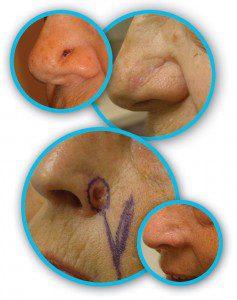By Ted F. Kadivar, M.D., F.A.C.S. –


It is well known that basal cell carcinoma is usually caused by exposure to the sun, but it is important to remember that ultraviolet (UV) radiation also comes from tanning booths and sunlamps. Twenty percent of basal cell carcinoma occur in areas not heavily sun exposed, such as the chest, back arms, legs and scalp. The face is the most common area for basal cell carcinoma lesions and half of those occur on the nose.
Basal cell lesions can be flat or raised. When they are flat, they are pink or red and rough to touch. When they are raised, they tend to be pearly white and have small blood vessels visible on the surface. Unlike most cancers, spread to distant sites is very rare, but basal cell carcinoma can damage and disfigure the eye, ear or nose as it slowly grows nearby.
In the vast majority of cases surgical excision is the treatment of choice and curative. This is usually easily accomplished in the office using local anesthesia in the area of the lesion. If the diagnosis is in doubt prior to an excision a biopsy can be done first by taking a small sample. In some areas, like on the nose, the skin may not be loose enough to pull the surrounding skin together. In those situations advanced closure techniques are required. These include various flaps in which additional incisions are made to swing skin from nearby to cover the surgical defect. Another option is a skin graft. A donor piece of skin is removed from a separate site and sewn in place at the original surgical site. For the nose, for example, commonly skin from right in front of or right behind the ear will match the color and thickness of the nose well.
The prevention of basal cell carcinoma, like all skin cancers, involves limiting UV ray exposure.
• limit sun exposure during peak hours (10am-2pm)
• use sunscreen of 30SPF or higher and reapply often
• wear broad brimmed hats and tightly woven protective clothing
• annual skin exam
Once a basal cell carcinoma is diagnosed, that individual has a forty percent chance of another lesion in the next five years, so vigilance is important for those patients.
Ted F. Kadivar MD PA
250 2nd St E • Suite 4C
Bradenton, FL 34208
941 744-5860
 Southwest Florida's Health and Wellness Magazine Health and Wellness Articles
Southwest Florida's Health and Wellness Magazine Health and Wellness Articles

